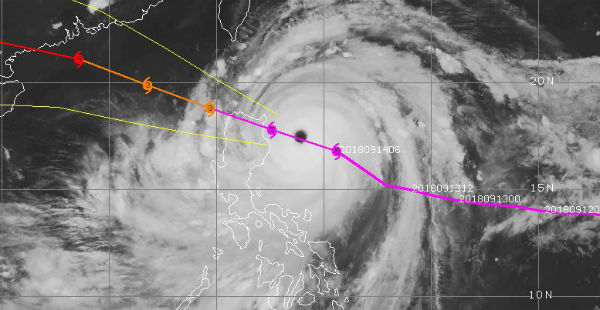
Super Typhoon Mangkhut is now heading for the Philippines. It is expected to strike the nation later in the night itself over the extreme northern parts of Philippines, possibly over Luzon. Mangkhut is currently a Cat 5 Typhoon packing winds of 285 kmph. Mangkhut is likely to make landfall as a Cat 5 Typhoon itself.
However, after striking Philippines, it is expected to weaken and will cross over to China Sea as a Cat 3 Typhoon. Moreover, Mangkhut will further gain strength in the open waters of South China Sea and become a Cat 4 Typhoon. It will make another landfall over the east coast of China as a Cat 4 Typhoon.
On the other side, in the North Atlantic Ocean, another Godzilla storm, Hurricane Florence has made landfall over North Carolina. However, Mangkhut is massive in all respects and much more devastating than Florence in terms of destruction, size as well as speed.
Evacuation of several thousand has been taking place in Philippines, as 4 million residents in the north brace for the direct hit of this mammoth Typhoon. Emergency has been in place for several parts of Philippines along with other parts of Southeast Asia including Hongkong.
The irony is that a storm Barijat has already hit the region and Mangkhut is right at its heels. Mangkhut is the strongest storm formed in the Pacific along with being one of the deadliest in the history of Pacific Storms.
Mangkhut has already battered Guam as well as Marshall Islands resulting in flooding rains and power outages and is now heading towards Luzon Island in Philippines. The eye of Mangkhut is 125 km wide, and the bigger the eye the calmer the situation is before the storm lashes the region.
The fear of Mangkhut is remembered by the Philippians in the form of Typhoon Haiyan, which had caused immense damage in 2013 causing the death of more than 6,000. Another Super Typhoon Haima which had lashed Philppines in 2016 had also caused massive destruction destroying 14000 homes in Luzon.
As per the National Disaster Risk Reduction and Management Council (NDRRMC) about 5.2 million people in 125 km radius will be exposed to Mangkhut.
Image Credit: CIMSS
Please Note: Any information picked from here must be attributed to skymetweather.com


